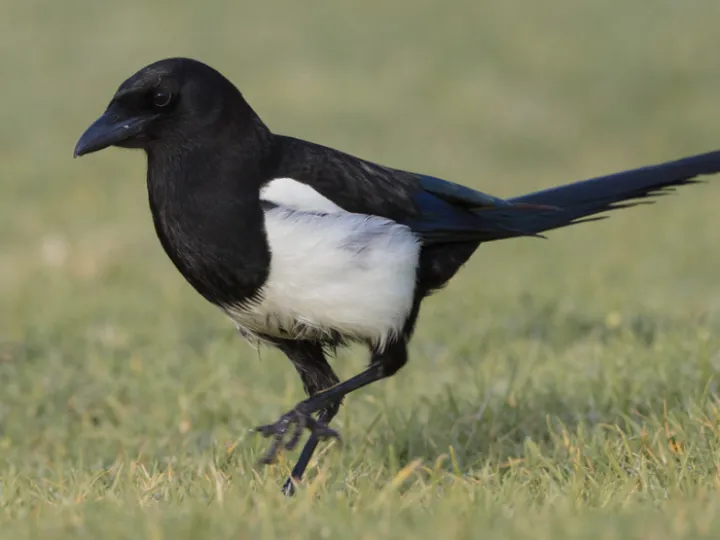Tarvin Birds – The Magpie
Birds in Tarvin Community Woodland.
The Magpie
(Pica pica)
{
}Click on the birdsong link if you really want to listen to the song of the Magpie in a separate tab while you read this article: https://www.youtube.com/watch?v=Kz4SvP0c_VE(Magpie Call) {
}
With its noisy chattering, black-and-white plumage and long tail, there is nothing else quite like the magpie in the UK. Another member of the Crow family (the Corvids), it is brighter and more colourful than the rooks, crows and ravens but a good deal less eye-catching than the jays. When seen close-up its (apparently) black plumage takes on an altogether more colourful hue with an iridescent purplish-blue sheen to the wing feathers and a greenish gloss to the tail. They also tend to spend the entire year within their particular territory; their preferred surrounding being open countryside with scattered trees. Magpies are normally absent from treeless areas and dense forests. Nowadays, they sometimes breed at high densities in suburban settings such as parks and gardens and can often be found close to the centre of cities. Magpies are omnivorous, eating young birds and eggs, small mammals, insects, scraps and carrion, acorns, grain, and other vegetable substances.
Magpies were originally known as simply "pies" – a word which, in the depths of antiquity, meant "pointed", in reference to either their beak or their tail. The prefix "mag" dates from the 16th century and comes from the short form of the forename Margaret, which was once used to mean women in general (just as Joe or Jack is used for men today). The bird's call was considered to sound like the idle chattering of a woman, and so it came to be called the "Mag pie". "Pie" as a term for the bird dates to the 13th century, and the word "pied", first recorded in 1552, became applied to other birds that resembled the magpie by having black-and-white plumage.
The magpie is believed to be not only one of the most intelligent of birds but among the most intelligent of all animals. The part of its brain called the nidopallium (responsible for higher cognitive tasks) is relatively to its size the same approximate size as in the brains of chimpanzees, gorillas, orangutans and humans. The magpie is the only bird known to pass the mirror test, which assesses a creature's ability to recognise itself visually. Other than mankind and some of the great apes, there are very few species of creature that are able to do this. Interestingly, the cognitive abilities of the magpie are regarded as evidence that intelligence evolved independently in both the corvids (the crow family) and the primates (the great apes – which includes man). This is indicated by, among other things, their use of tools and their ability to hide and store food across the seasons. Another behaviour that exhibits their intelligence is the way that they cut food in correctly sized proportions for the size of their young. In captivity, magpies have been observed counting up to get food, imitating human voices, and regularly using tools to clean their own cages. In the wild, they organise themselves into gangs and use complex strategies when hunting other birds and when confronted by predators.
Some magpies wait to breed in their second year, having remained in non-breeding flocks for their first year. When they do breed, they form a pair-bond and these pairs often remain together from one breeding season to the next, remaining in the same territory on successive years. Mating takes place in spring. Magpies prefer tall trees for their bulky nest, which is firmly attached to a central fork in the upper branches. A framework of the sticks is cemented with earth and clay, and a lining of the same is then covered with fine roots. Above is a stout (though loosely built) dome of prickly branches with a single well-concealed entrance. While invisible in Spring and Summer, these huge nests are quite conspicuous when the leaves fall. Where trees are scarce (even in well-wooded country), nests may be built in bushes and hedgerows.
Clutches of five or six eggs are typically laid in April. The eggs are laid in early morning, usually at daily intervals. The eggs are small for the size of the bird and typically are pale blue-green, with close specks and spots of olive brown, although much variation in markings can be shown.
The eggs are incubated for 21-22 days by the female, who is fed on the nest by the male. The chicks hatch nearly naked and with closed eyes. They are brooded by the female for the first 5-10 days and are fed by both parents. Initially the parents eat the faecal sacs of the nestlings, but as the chicks grow larger, they learn to defecate over the edge of the nest. The nestlings open their eyes between 7 and 8 days after hatching. Their body feathers start to appear after around 8 days and the primary wing feathers after 10 days. For several days before they are finally ready to leave the nest, the chicks clamber around the nearby branches. They fledge at around 27 days, but the parents then continue to feed the chicks for several more weeks. They also protect the chicks from predators, as their ability to fly is poor, making them particularly vulnerable. On average, only 3 or 4 chicks survive to fledge successfully. Some nests are lost to predators, but an important factor causing nestling mortality is starvation. Magpie eggs hatch one after another, and if the parents have difficulty finding sufficient food, the last chicks to hatch are unlikely to survive. Only a single brood is reared, unless a disaster were to overtake the first clutch.
There is a great deal more to our magpies that we might ever have realised!
Quick Links
Get In Touch
TarvinOnline is powered by our active community.
Please send us your news and views.









